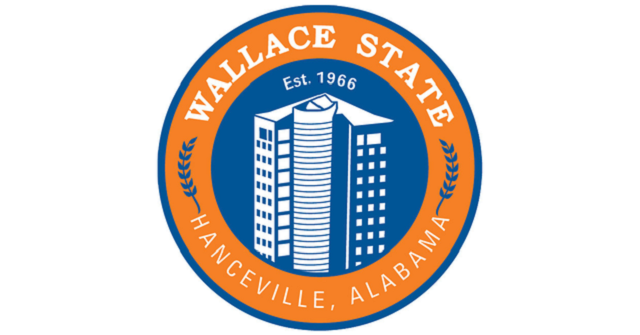HANCEVILLE – On Monday, the U.S. Department of Education announced Wallace State Community College in Hanceville is one of 44 colleges in the nation—and the only college in Alabama—to be selected as an experimental site for the use of Federal Pell Grants for dual enrollment.
As part of the “Expanding College Access Through the Dual Enrollment Pell Experiment,” for the first time an estimated 10,000 high school students in the U.S. will have the opportunity to access approximately $20 million in Federal Pell Grants to take dual enrollment courses provided by colleges and high schools.
“Wallace State has worked diligently for the better part of the last decade to improve access, learning, and completion for students, and with great success,” said Wallace State President Dr. Vicki Hawsey Karolewics. “In addition to our work with Achieving the Dream, the American Association of Community Colleges (AACC) Pathways Project, and the American Association of Colleges and Universities (AAC&U) Community College Roadmap Project,having been selected for the Dual Enrollment Pell Experiment adds one more resource to our toolkit to ensure that ambitious high school students are accelerated to completion and into the workforce more quickly than their counterparts. We are honored to have been selected from a very competitive pool of applicants for this important experimental program.”
This new experimental program builds on the Administration’s work to expand college opportunity, including efforts to redesign America’s high schools and America’s College Promise, the President’s vision to make two years of community college free for responsible students. Nearly 80 percent of the selected sites in the experiment are community colleges.
“We are delighted that Wallace State was chosen to participate in this experiment and believe it is a testament to the quality of the programs we have in place,” said Diana Majerik, Director of Wallace State Dual Enrollment, Fast Track, and Off Campus Programs.
Wallace State currently has dual enrollment agreements with eight local education agencies (Blount County, Cullman City, Cullman County, Jefferson County, Morgan County, Oneonta City, Walker County and Winston County) to allow qualified high school students to enroll in college-level courses and earn dual credits toward a high school diploma and postsecondary degree.
The college offers three options for dual enrollment with partnering school systems:
Dual Enrollment – Students may enroll in dual credit courses taught by qualified faculty on the high school campus, as well as, on the campus of Wallace State beginning in their sophomore year.
Fast Track Academy – High school juniors and seniors are enrolled full-time at the high school on the community college campus, but return to their home high school to participate in extracurricular, clubs, and school activities. Dual credit core courses are taught in the Academy classrooms as well as across campus, while major and elective dual credit courses are a offered in a blended format in the respective programs. Students who enter the program as juniors have the opportunity to graduate with a high school diploma and an associate’s degree from Wallace State by the end of their senior year in high school.
Fast Track for Industry – An extension of the Fast Track Academy dual enrollment program, Fast Track for Industry is focused on career pathways. Students in Fast Track for Industry are currently enrolled in 23 Wallace State programs of study and are offered opportunities for internships, apprenticeships, and cooperative education experiences, focused on the high-demand occupation fields in the service area.
Earning a college degree is an increasingly important step toward entering the middle class. Yet fewer than 10 percent of children born in the bottom quartile of household incomes attain a bachelor’s degree by age 25, compared to over 50 percent in the top quartile, reports the National Bureau of Economic Research. Many high school students—especially those from low-income backgrounds—lack access to the rigorous coursework and support services that help prepare them for success in college.
In Fall 2015, Wallace State served 564 dual enrollment students, and expects that number to grow with the opportunity for some students to qualify for Pell funding.
“Currently, 65 percent of Wallace State students receive some type of financial aid, so we know there are many high school students in our area who will benefit greatly from this program,” said Majerik.
In his 2013 State of the Union Address, President Obama laid out a new vision for America’s high schools, proposing funding to scale up innovative high school models and partnerships with colleges and employers so that all students can access a high-quality education and be prepared to pursue their educational and career goals. These models aim to strengthen America’s high schools by supporting stronger partnerships to expand access to rigorous coursework, support personalized learning, provide students with the chance to build work-based competencies, and allow for innovative approaches to drive student achievement.
“Innovation is an important underpinning in our efforts to expand college access and increase college completion for our nation’s students,” said U.S. Under Secretary of Education Ted Mitchell. “We’re thrilled these institutions have joined us in answering the President’s call to reimagine the high school experience and create stronger linkages to college coursework. These sites will help us learn how the availability of Pell Grants impacts participation and success in dual enrollment programs.”
Promoting College Access and Success Through Dual Enrollment
According to the National Center for Education Statistics, in the 2010-2011 school year, more than 1.4 million high school students took courses offered by a college or university for credit through dual enrollment. A growing body of research suggests that participation in dual enrollment can lead to improved academic outcomes, especially for students from low-income backgrounds and first-generation college students. Research suggests that participation in dual enrollment can lead to better grades in high school, increased enrollment in college following high school, higher rates of persistence in college, greater credit accumulation, and increased rates of credential attainment. (see sources below)
In the 2015-16 academic year, 96 percent of students who had enrolled in Wallace State’s Fast Track Academy progressed or completed the program successfully. The most recent Fast Track Academy graduating class has already reported more than $1,052,076 million in scholarships and counting, with one student receiving $126,512 in scholarship offers and another receiving $213,000 in offers to date.
But while dual enrollment models have shown promising academic outcomes for students, the National Center for Education Statistics finds that cost can be a barrier: at nearly half of institutions with dual enrollment programs,most students pay out of pocket to attend. Under the experimental sites authority of section 487A(b) of the Higher Education Act, which allows the Department to test the effectiveness of statutory and regulatory flexibility for postsecondary institutions that participate in the Federal student aid programs, the Secretary will waive existing financial aid rules that prohibit high school students from accessing Federal Pell Grants. Through this experiment, the Department hopes to learn about the impact of providing earlier access to financial aid on low-income students’ college access, participation, and success.
Selected experimental sites are required to ensure Pell-eligible students are not responsible for any charges for postsecondary coursework after applying Pell Grants, public and institutional aid, and other sources of funding.
Advancing Practices that Promote College Access and Success
The invitation to Wallace State and other colleges to join this experiment was based, in part, on some key features designed to make students successful in college and careers, which were already in place. Some of these features include:
Academic preparation and credit accumulation: These programs ensure that students meet academic requirements, keep their grades up, and are engaged in a quality curriculum, including offering a minimum of 12 credits toward a postsecondary credential. Dual enrollment and Fast Track students at Wallace State often graduate high school with a semester or more of college-level credit. This year, one student not only earned approximately one year of college credit, she also graduated high school a year early. Another Fast Track student earned an associate degree and her high school diploma in the same month.
Advising and other support services: Most of these programs provide students with access to personalized academic advising or guidance counseling. Additionally, participating institutions and their secondary school or school district partners will commit to assisting their dual enrollment students with completing the Free Application for Financial Student Aid (FAFSA) to determine their eligibility to receive Federal Pell Grants. All first-time Wallace State students are provided with a Success Coach for their first year. Students may opt to continue with their coach into the second year, should they elect to do so. The Success Coach establishes a relationship with each student through a research-based coaching model, providing support across all areas of student success including academics, career, finances, school community, time management, commitment to graduation, and health/wellness. Coaches also serve as liaisons to multiple student services to prepare and support dually enrolled students in postsecondary education. These services include academic tutoring, academic advising, career counseling, and financial resources. Wallace State supports all students with a 360 degree approach to student success and ensuring access to services.
Pathways to further their studies: All students participating in dual enrollment arrangements are one step ahead in their pursuit of a postsecondary credential. Many of the programs selected for participation create clear pathways programs for their dual enrollment students to continue their studies at the postsecondary institution and/or transfer the credits they’ve earned to other institutions of higher education in the local area. Wallace State offers guaranteed and seamless transfer of credit to universities through the STARS statewide articulation system. The college was also selected last fall as one of only 30 colleges in the nation to participate in the inaugural Pathways Project led by AACC.
Providing a teaching foundation for STEM and alignment with workforce needs: Many of the selected programs help students get a foundational education that will prepare them to succeed in college and their careers. Some examples of the focus of these programs support students in developing the critical-thinking skills and foundational knowledge for STEM fields and others that align with local workforce needs including advanced manufacturing, machining, welding, aviation, health sciences, software engineering, computer information systems, and business computer applications. Each of Wallace State’s dual enrollment programs provides opportunities for an emphasis in STEM.
Finally, participation in this experiment will enable Wallace State and other colleges to expand the number of students they serve—in particular, more Pell-eligible students from low-income backgrounds—and may also allow some students to pursue additional courses for college credit.
The dual enrollment experiment builds on the Administration’s efforts – most notably through the First in the World program for higher education and the Investing in Innovation (i3) Fund for PK-12 – to support innovative solutions while building the evidence base to identify and promote promising strategies that improve educational outcomes. The Administration’s $70 billion investment in community colleges includes $100 million in America’s Promise Grants for education and training, increased funding and access to education through Pell, HEA Title III and V programs and the Trade Adjustment Assistance Community College Career Training (TAACCCT) Grant Program. The dual enrollment experiment program also complements the Administration’s work to promote Next Generation High Schools and rethinking how high schools educate our students and prepare them for college and careers through stronger partnerships between higher education and K-12.
As this new Pell experimental program is in the implementation stage, additional details and guidelines will be forthcoming. However, parents and students interested in dual enrollment and Fast Track opportunities at Wallace State this fall are encouraged to complete the FAFSA as soon as possible. Visit www.wallacestate.edu/programs/dual-enrollment/fafsa to get started.
For more information about Wallace State, visit www.wallacestate.edu or call 256-352-8000.
###
2016 Postsecondary Institutions Invited to Participate
44 postsecondary institutions across 23 states have been invited to participate.
- Adams State University (Alamosa, Colorado)
- Asnuntuck Community College (Enfield, Connecticut)
- Bard College (Annandale-on-Hudson, New York)
- Benedict College (Colombia, South Carolina)
- Bristol Community College (Fall River, Massachusetts)
- Carl Sandburg College (Galesburg, Illinois)
- Cayuga Community College (Auburn, New York)
- Central Virginia Community College (Lynchburg, Virginia)
- College of Southern Maryland (La Plata, Maryland)
- Community College of Beaver County (Monaca, Pennsylvania)
- Cowley County Community College (Arkansas City, Kansas)
- Gateway Community College (New Haven, Connecticut)
- George C. Wallace State Community College (Hanceville, Alabama)
- Germanna Community College (Fredericksburg, Virginia)
- Glenville State College (Glenville, West Virginia)
- Guilford Community College (Jamestown, North Carolina)
- Hagerstown Community College (Hagerstown, Maryland)
- Holyoke Community College (Holyoke, Massachusetts)
- Illinois Central College (East Peoria, Illinois)
- Jackson State University (Jackson, Mississippi)
- Leeward Community College (Oahu, Hawaii)
- Louisiana State University (Eunice, Louisiana)
- Mississippi Gulf Coast Community College (Perkinstown, Mississippi)
- Naugatuck Valley Community College (Waterbury, Connecticut)
- Niagara County Community College (Sanborn, New York)
- North Country Community College (Saranac Lake, New York)
- Northeast State Community College (Blountville, Tennessee)
- Northeastern Technical College (Cheraw, South Carolina)
- Norwalk Community College (Norwalk, Connecticut)
- Owensboro Community and Technical College (Owensboro, Kentucky)
- Quinebaug Valley Community College (Danielson, Connecticut)
- Ranger College (Ranger, Texas)
- Ranken Technical College (St. Louis, Missouri)
- Southern New Hampshire University (Manchester, New Hampshire)
- Southwest Tennessee Community College (Memphis, Tennessee)
- Southwestern Illinois College (Belleville, Illinois)
- Sullivan County Community College (Loch Sheldrake, New York)
- SUNY Adirondack (Queensbury, New York)
- SUNY Rockland Community College (Suffern, New York)
- Three Rivers Community College (Norwich, Connecticut)
- University of Arkansas Community College (Hope, Arkansas)
- University of Nevada (Reno, Nevada)
- Urban College of Boston (Boston, Massachusetts)
- William R. Moore College of Technology (Memphis, Tennessee)
Sources:
Bailey, M, and Dynarski, S. (2011). Gains and Gaps: Changing Inequality in U.S. College Entry and Completion. National Bureau of Economic Research. http://users.nber.org/~dynarski/Bailey_Dynarski.pdf
Marken, Stephanie et al. (2013). Dual Enrollment Programs and Courses for High School Students at Postsecondary Institutions: 2010–11. U.S. Department of Education, National Center for Education Statistics. http://nces.ed.gov/pubs2013/2013002.pdf
Karp, M, and Hughes, K. (2008). Study: Dual Enrollment Can Benefit a Broad Range of Students. Techniques: Connecting Education and Careers (J1) 83.7, 14-17.
An, B. P. (2012). “The Impact of Dual Enrollment on College Degree Attainment: Do Low-SES Students Benefit? Educational Evaluation and Policy Analysis, 35, 57–75.
Karp, M. M., Calcagno, J. C., Hughes, K. L., Jeong, D. W., & Bailey, T. R. (2007). The Achievement of Participants in Dual Enrollment: An Analysis of Student Outcomes in Two States. Saint Paul, MN: University of Minnesota,National Research Center for Career and Technical Education.
Marken, Stephanie et al. (2013). Dual Enrollment Programs and Courses for High School Students at Postsecondary Institutions: 2010–11. U.S. Department of Education, National Center for Education Statistics. http://nces.ed.gov/pubs2013/2013002.pdf


















